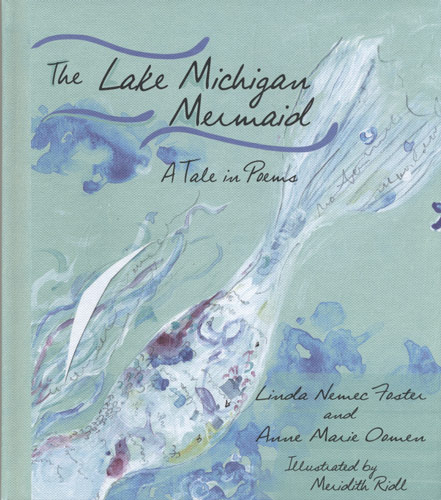The Lake Michigan Mermaid
The Lake Michigan Mermaid is a beautiful and haunting collection of poems about a relationship between a young girl and a freshwater mermaid. The poems alternate between the voice of the girl and voice of the mermaid, with Anne-Marie Oomen writing the girl’s poems and Linda Nemec Foster writing the mermaid’s. And woven throughout the book are lovely watercolor illustrations by Meridith Ridl.
The Lake Michigan Mermaid is a beautiful and haunting collection of poems about a relationship between a young girl and a freshwater mermaid. The poems alternate between the voice of the girl and voice of the mermaid, with Anne-Marie Oomen writing the girl’s poems and Linda Nemec Foster writing the mermaid’s. And woven throughout the book are lovely watercolor illustrations by Meridith Ridl.
The book tells the story of a girl named Lyk, who lives in a cottage near the shore of Lake Michigan with her mother and grandmother. The collection’s first poem, “Lyk,” shows that she’s curious about the lake—and also about someone she thinks might live out in the water:
Each day I wonder if there might
be a being out there, beyond that linemy mom calls the thin blue lip of blue lake,
a being who would say Lyk like the namewas meant to join one joyful thing to some
other joyful thing. Is there any one?
Lyk has a plaintive sense of longing, which forms the basis of her connection with this mythical being. Indeed, these poems are all about connection, with the mermaid trying, too, to reach across the divide of land and water. In “Hearing My Name” the mermaid addresses Lyk:
Perhaps you
heard my name in
your dream last night when the
lonely sound of
ice captured the waves.
In the back-and-forth between them, the girl and mermaid gradually become more real to each other as reflections between human and creature, shore and water, culture and nature. In “Your Face Reflected in Mine,” the mermaid addresses Lyk as follows:
Look down into the midnight water
and see me. Your face above, mine below.
Our contours mirror each other. The girl
who loves the water merged with the girl
who lives within.
The mermaid might be the girl’s vision of herself—perhaps an older and wiser self. The mermaid is also a voice for the lake itself, that mysterious fluid place that is, nonetheless, linked indelibly to land. This collection is about all of those connections we form with the world around us, and the ways we see ourselves mirrored in the world.
Eventually, Lyk’s mother is forced to put the cottage up for sale because of financial reasons, and Lyk, who loves the life they have by the lake, is deeply hurt by this turn of events. She and her mother argue in “After Supper” about the impending sale:
I tell her
I’ll get a job and give her all the money,
that I’ll even babysit, which I hate.She doesn’t listen until I tell her
I’ll steal something I can sell
for real money—I’ll save us that way.
After she slaps me hard, she cries too.
This slap is painful and distressing, sending shockwaves out of the house and to the lake, where even the mermaid hears it. It’s also moment when a deep rift opens between Lyk and her mother, a rift made even deeper when her grandmother goes into a nursing home.
To deal with this trauma and stress, Lyk is further drawn to the lake and the mermaid she’s sure is there. At a climactic moment in the collection, she falls into the water, comes into contact with the mermaid, and finds herself saved from the water by both the mermaid and her mother, who sings to her gently while they sit on the sand, saying, “Not you too. / I can’t lose you too” (“Her Hair”). In this powerful moment, the bond that had eroded between mother and daughter begins to be re-established.
After the cottage sells, Lyk realizes that she still has the lake—and the mermaid—inside her. The lake will always be her home, she comes to understand, even though her family no longer owns that land: “The waves / hit the shores inside me now” (“The Room Weeps”).
The final poem, “Contrapuntal: Two Voices of the Lake,” includes a back-and-forth dialogue between Lyk and the mermaid as they join together to become one, ending with this line: “they know they are home.” It’s a moving conclusion to a collection that is all about finding one’s home and learning to think about home in ways that are larger than owning a particular piece of property.
The watercolor paintings throughout this book are a beautiful addition to the poems. They tell the story through dreamy, impressionistic images of lake, shore, and cottage, and watercolor—with its fluidity and its basis in water—is the perfect medium for these paintings.
The Lake Michigan Mermaid is a moving book about a girl’s coming of age, about loss, and about learning to feel at home on earth.





